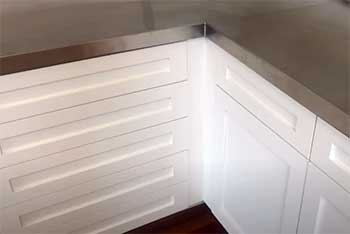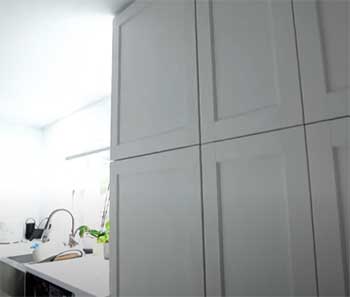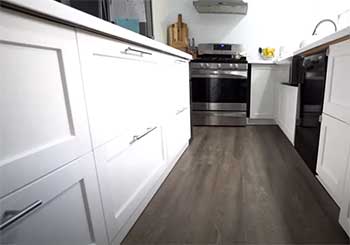If you’re in the market for new kitchen cabinets, you’re likely considering options from Barker and IKEA. These two brands offer affordable cabinetry solutions but have key differences in terms of quality, customization, and value.
This comprehensive guide will compare Barker and IKEA cabinets to help you determine which is the best fit for your kitchen remodel or renovation.
A Brief Comparison Table
| Factor | Barker Cabinets | IKEA Cabinets |
| Construction | Plywood boxes, solid wood doors | Particle board boxes, veneer doors |
| Hardware | Blum, soft-close, dovetail joinery | Blum, soft-close, basic joinery |
| Finishes | Catalyzed varnish | UV cured paint |
| Quality | Very durable, lifetime warranty | Decent for price, 25 year warranty |
| Customization | Fully customizable sizing and layouts | Modular sizing, limited flexibility |
| Cost | $250-350 per cabinet | $100-150 per cabinet |
| Installation | Professional, included | DIY, additional cost |
| Styles | Traditional and contemporary aesthetics | Very modern and trendy aesthetics |
| Eco-Friendly | Limited recycled materials | Recycled and sustainable materials used |
| Purchase Process | Through authorized dealers | IKEA stores and website |
Overview of Barker Cabinets
Barker cabinets are made by MasterBrand, one of the largest cabinet manufacturers in North America. They offer a range of modular cabinet lines at approachable price points while maintaining a focus on quality construction and materials. Here’s an overview of what you can expect with Barker:

- Quality Materials – Barker cabinets are constructed from plywood boxes and hardwood doors and drawers. They use quality joinery and hardware too. This results in a durable product.
- Wide Range of Styles – From shaker to inset to modern looks, Barker has many door styles and finish options to match most kitchen aesthetics. Their styles accommodate both traditional and contemporary kitchen designs.
- Customization Available – Barker allows you to modify cabinet sizes and layouts to work with your exact kitchen measurements. Their semi-custom line offers over 40 cabinet sizes.
- Reasonable Cost – Barker provides a good value, with prices per cabinet ranging from $100-300. More customization does come at an added cost.
- Expert Installation – Barker cabinets must be professionally installed to get the warranty. This ensures your new cabinets are leveled and secured correctly.
Overview of IKEA Cabinets
As one of the most popular budget-friendly cabinet brands, IKEA is known for their flat packed assemble-it-yourself approach. Here are some key factors to consider about IKEA kitchen cabinets:

- Lower Price Point – IKEA cabinets are typically priced between $50-150 per cabinet, making them very wallet-friendly. You save by assembling them yourself.
- Modular System – The SEKTION system has cabinets in standard sizes for streamlined installation. You can interchange them in different configurations.
- Limited Customization – IKEA’s sizing options and modifications are not as robust as a semi-custom brand. But extras like drawers can be added easily.
- Diverse Styles – From modern matte fronts to classic shaker doors, IKEA offers many aesthetics. Their catalog has over 100 door styles and colors.
- Particle Board Construction – IKEA uses particle board instead of plywood for the cabinet boxes. There are some concerns about long-term durability.
Key Differences Between Barker And IKEA Cabinets
Now that we’ve looked at an overview, let’s do a detailed comparison of factors that impact your decision.
Quality and Durability Comparison
Arguably the most important consideration for long-lasting kitchen cabinets is their quality and durability. This includes the materials used, hardware, and craftsmanship.
- Materials
Barker cabinets are constructed using 3⁄4” thick plywood for the sides, floors, ceilings and cabinet backs. Plywood is stronger and resists warping better than particle board. The doors feature solid hardwood frames and plywood center panels.
On the other hand, IKEA cabinets employ particle board for the boxes and back walls. The doors are typically a veneer over particle board or fiberboard. While the particle board is decent, plywood is regarded as the superior and longer-lasting material.
- Hardware
Both Barker and IKEA use Blum brand hinges and drawer glides that are soft-closing. These high-quality hardware components allow for smooth opening and closing.
For drawer boxes, Barker uses solid wood dovetail joinery while IKEA opts for a simple rabbet construction. Dovetails are markedly stronger and endure more wear-and-tear.
- Finishes
The finish application impacts durability too. Barker sprays cabinets with a high-quality, catalyzed conversion varnish for a furniture-like finish. Multiple coats are applied for increased protection.
IKEA uses a thinner direct-to-board UV cured acrylic paint. Though durable, it is not as robust as a professional-grade catalyzed system. Without proper prep, the finish can chip over time.
- Craftsmanship
Barker’s cabinets are made in the USA in company-owned plants under strict quality control. IKEA’s cabinets are outsourced globally to various manufacturers. Consistency and precision may vary more.
Considering these factors – the plywood boxes, dovetail drawers, and conversion varnish finish allow Barker cabinets to better stand the test of time. The hardware is excellent on both. IKEA is decent given the low price, but Barker is the winner for quality and durability.
Customization and Flexibility
Having cabinets that fit your space optimally requires some level of customization. Barker and IKEA offer different approaches:
- Sizing

One of the biggest differences is Barker’s sizing flexibility compared to IKEA’s modular system.
Barker’s semi-custom line includes over 40 cabinet box sizes, plus custom widths and heights by entering exact measurements.
Their innovative variable height wall cabinets also provide optimal space usage compared to fixed sizings.
IKEA’s sizing is far more limited and based on their set SEKTION cabinet dimensions. You can add interior fittings though. The assembly process also makes modifying IKEA cabinets more difficult than a professional brand.
- Cabinet Layouts
Barker’s semi-custom offering allows true customization of cabinet footprints and kitchen layouts. Their designers can create the ideal workflow and storage solutions for how you use your kitchen.
While IKEA kitchen planners help optimize the layout, you still have to work within the parameters of their existing cabinet sizes and limitations. There is less flexibility unless you want to heavily modify cabinets.
- Storage Solutions
Both Barker and IKEA allow you to add organizational elements like drawer partitions, spice pull-outs, lazy susans and more. Barker’s semi-custom nature provides more flexibility in placement and sizing of these specialty items. With IKEA, your limited to what can fit within their existing cabinet boxes.
- Accents
Want a glass cabinet front or open shelving? Barker’s made-to-order approach accommodates small custom touches like this easily. IKEA’s cabinets focus on modular consistency, making one-off customizations harder. But they do offer a broad array of door styles.
If customization is important to you, Barker provides the most flexibility. Their cabinet sizing, storage solutions, and overall layouts can be adapted fully to your kitchen’s needs. IKEA is far more standardized.
Cost Comparison
One of the biggest factors that draws people to IKEA is the affordable price point. There is no denying you will pay more for Barker’s semi-custom offering. Let’s look at cost considerations:
- Base Cabinets
An IKEA kitchen starts around $100-150 per base cabinet plus another $30-50 for doors and drawers. Barker’s equivalents are in the $250-350 range per standard base cabinet. Recoating IKEA cabinets professionally adds roughly $100-150 per cabinet.
- Installation
IKEA’s cabinets are designed for DIY installation. If you pay a contractor, you’ll spend at least $1000 for assembly and hanging. Barker’s lifetime warranty requires expert installation, but this is included in the overall project cost.
- Countertops
IKEA’s partnership with Caesarstone allows you to purchase coordinating countertops conveniently. Barker supplies cabinets only, so you have to source countertops separately. Material costs are similar from third party fabricators.
- Long-term Value
Barker’s plywood construction and superior finish can help the cabinets last 25-30 years or longer. Some IKEA cabinets have durability issues that become apparent after 5-8 years and require refinishing or replacement. Spending more upfront can save costs down the road.
Ultimately IKEA provides the lowest entry price, but Barker delivers better value per dollar spent when you factor in longevity and a hassle-free installation.
Style and Design Options
Beyond functionality, you want cabinets that match your home’s style. Barker and IKEA each offer many aesthetic options.
- Door Styles
From shaker to inset to slab, Barker has over 25 door styles that cater towards traditional and contemporary kitchens alike. Their popular William, Kendall, and Craftsman lines provide timeless looks.
IKEA has over 100 door options spanning sleek minimalist to elaborate traditional. Their most popular styles are shaker Vikanes and slab Bodbyn. IKEA’s catalog is unrivaled for trendy and modern styles.
- Colors
Barker offers a palette of 30 paint and stain options, including popular white and gray tones alongside warm wood stains.
IKEA has over 50 door colors from bright greens to dark navy blues. Their colors veer modern and eclectic. Barker’s hues are more subdued and classic.
- Custom Finishes
Barker also provides fully custom paint or stain matching if you have a specific hue in mind, at an added cost. This level of customization isn’t an option through IKEA.
- Organizational Options
Both brands allow you to add functional elements like roll-outs, drawer dividers, and other specialty storage items. Barker can fully customize sizing and placement; IKEA is limited to what fits their cabinet dimensions.
- Modern Touches
IKEA excels at contemporary designs like integrated handles and hidden hinges for a streamlined look. Barker also offers a modern line, but IKEA has greater variety.
IKEA’s catalog provides endless inspiration for cool and modern kitchen elements. Their styles cover the mid-century modern and Scandinavian aesthetics well. Barker caters more to traditional and timeless kitchen designs.
Environmental Factors
Eco-conscious shoppers will also want to compare the brands’ commitments to sustainability:
- Materials
Barker has adopted industry environmental standards for sourcing lumber from managed forests. Much of IKEA’s wood also comes from responsibly managed forests.
- Manufacturing
Barker Cabinetry’s US-based factories utilize solar power and green manufacturing principles. IKEA partners with suppliers focused on sustainability as well, though oversight varies more.
- Recycled Content
IKEA offers doors and surfaces made from recycled wood or transparent acrylic. Some doors contain 50-70% recycled content. Barker does not incorporate recycled materials at this time.
- Chemicals
Both brands avoid toxic chemicals, and IKEA bans formaldehyde. Adhesives and finishes meet health standards. IKEA provides detailed information on their materials for transparency.
- Packaging
IKEA’s flat pack model requires less packaging and enables efficient transport. Barker’s ready-to-assemble cabinets have more packaging waste.
On the environmental front, IKEA’s commitments edge out Barker’s efforts slightly, helped by their recycling initiatives and minimal packaging. But both brands are fairly comparable.
Purchase and Installation Process
The purchase and installation process also impacts your experience:
- Purchasing
Barker cabinets must be purchased through one of their authorized dealers. This allows you to get expert recommendations for your specific kitchen.
IKEA cabinets can only be purchased at IKEA stores or online through their site. There is less one-on-one guidance.
- Measurement & Planning
To purchase Barker cabinets, dealers measure your space and design the full kitchen layout. IKEA provides similar design services in-store or online, but measurements are your responsibility.
- Lead Times
Both made-to-order Barker cabinets and IKEA cabinets involve a 2-8 week lead time. Barker’s production time increases with more customization.
- Installation
Assembling and hanging IKEA cabinets yourself saves on labor costs but requires DIY skills. Having Barker cabinets professionally installed takes the hassle out of it.
- Warranty
Barker provides a limited lifetime warranty but requires certified installers. IKEA has a more restrictive 25 year warranty that you must install correctly to uphold.
For a smooth process with less heavy lifting, Barker’s dealer network and included installation service makes things easier compared to piecing IKEA’s system together alone. But you’ll need to weigh the installer costs.
Which Is The Better Buy For You?
Now that we’ve explored the differences between Barker and IKEA cabinets in depth, let’s summarize the key factors to help you determine which is the better choice:
Barker Pros: superior quality and materials, truly custom sizing and layouts, expansive style options, easier buying and installation process
Barker Cons: higher upfront cost, limited eco-friendly materials
IKEA Pros: very budget-friendly, modern and unique styles, lower cost DIY installation, green materials
IKEA Cons: durability concerns with particleboard, limited sizing and customization, required assembly, restrictive warranty
Here are some final recommendations based on different needs:
- For a high-end custom look and quality construction, Barker is the clear choice. Their cabinets are an investment built to last decades.
- If you need to work within tight budget constraints, IKEA is likely the better option. You can get decent cabinets at entry-level pricing.
- Seeking lots of unique styling and colors? IKEA’s catalog can’t be beaten for variety and options.
- Prioritizing environmentally responsible materials may steer you towards IKEA’s recycled and sustainable products.
- If you value convenience and warranty protections, Barker’s turnkey service makes it a simpler upgrade. IKEA requires you to execute correctly.
Frequently Asked Questions (FAQ)
IKEA kitchen cabinets are much more affordable than many brands for several reasons:
1. Particle board construction reduces material costs compared to solid wood.
2. Flat packed cabinets minimize packaging and shipping costs.
3. DIY assembly keeps labor costs extremely low.
4. Their massive global supply chain provides economies of scale.
5. IKEA products are designed to be efficiently manufactured.
6. IKEA competes largely on low pricing strategy.
Together these factors allow IKEA to offer budget-friendly cabinets that sacrifice some features or quality for cost.
The highest quality cabinets use all plywood construction, dovetail joinery for drawers, and a professional sprayed finish. Sturdy frames and luxury hardware like soft-close mechanisms also contribute to premium quality. Solid hardwood doors and durable surfaces ensure long-lasting beauty as well. Leading cabinet brands like Barker meet these quality benchmarks.
Opt for all-plywood boxes, solid wood doors and drawers, and high-end finishes to get the most durable and long-lasting kitchen cabinets. Dovetail joinery and quality hardware also help cabinets endure years of use. Choose timeless styles over trendy looks. And work with established brands and manufacturers that back their quality with a strong warranty. With proper care, the best cabinets can easily last 25-30 years or longer.
Shaker style cabinets dominate today’s kitchen trends thanks to their classic, timeless appeal. Slab cabinet styles are also gaining steam for their minimalist and contemporary vibe. White and light gray painted finishes remain popular to brighten up kitchens and create a cohesive look. Integrated handles are on the rise for streamlined contemporary designs. Overall, clean lines and simplicity define modern kitchen cabinet style preferences at the moment.
Final Thoughts
While it requires a bigger upfront investment, Barker offers the best value long-term thanks to quality materials and construction. For quick updates or rental properties, IKEA provides a very wallet-friendly solution if you don’t mind the assembly.
Carefully weigh what’s most important in your kitchen to decide which brand truly suits your needs and lifestyle best.

